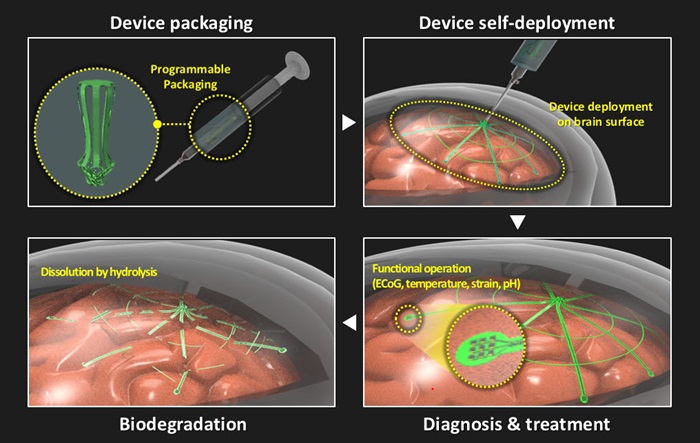Biodegradable Electronic Tent Technology Diagnoses Brain Disease Non-Invasively
|
By HospiMedica International staff writers Posted on 13 Aug 2024 |

High-density, large-area electronic interfaces are essential for brain-computer interface (BCI) technologies. Current diagnostic methods for conditions like epilepsy and Parkinson's disease often involve the use of large brain electrodes, necessitating the removal of a significant portion of the skull. This procedure comes with risks including brain hemorrhage, infection, cerebrospinal fluid leakage, and postoperative intracranial hypertension. There is a pressing need for less invasive alternatives to encourage the broader acceptance of bio and brain engineering technologies. To address this issue, researchers have developed a 'biodegradable electronic tent,' offering a new non-invasive approach to brain disease diagnosis.
The technology proposed in the internationally renowned journal Nature Electronics by scientists at the College of Engineering at Seoul National University (Seoul, Korea) utilizes a needle to implement a biodegradable electronic tent for diagnosing brain disorders. The electronic tent is designed to deploy smoothly between the narrow space of the skull and the brain, spanning a few millimeters. It is made from biodegradable shape-memory polymers and ultrathin biodegradable inorganic electronic devices. Injected through a small opening in the skull, the electronic tent expands to cover a large area comparable to the size of a palm. After serving its diagnostic purpose, the tent naturally dissolves within the body, eliminating the complications associated with permanent medical devices left inside the body, which is a common issue with traditional methods used in diagnosing epilepsy and Parkinson's disease.
The research team demonstrated the functionality of this technology by successfully measuring brainwave signals for two weeks using the biodegradable electronic tent in animal models. They also monitored the biodegradation process of the tent in vivo over a prolonged period, confirming its potential for practical use. The biodegradable electronic tent holds promise for revolutionizing the diagnosis of intractable epilepsy and Parkinson's disease by providing a minimally invasive method for placing electronic devices with a needle. This reduces the risks associated with conventional invasive surgeries and does away with the need for further surgical interventions to remove devices post-diagnosis. The technology is poised to expand its applications beyond epilepsy and Parkinson's to include other brain disorders like stroke and hydrocephalus. Furthermore, by minimizing the invasiveness of electrode insertion used in BCI technologies such as Neuralink's brain implants, it could decrease public resistance to these procedures, enhancing the viability of advanced BCI technologies.
Related Links:
College of Engineering at Seoul National University
Latest Critical Care News
- Novel Cannula Delivery System Enables Targeted Delivery of Imaging Agents and Drugs
- Ingestible Smart Capsule for Chemical Sensing in the Gut Moves Closer to Market
- Novel Intrabronchial Method Delivers Cell Therapies in Critically Ill Patients on External Lung Support
- Generative AI Technology Detects Heart Disease Earlier Than Conventional Methods
- Wearable Technology Predicts Cardiovascular Risk by Continuously Monitoring Heart Rate Recovery
- Wearable Health Monitoring Device Measures Gases Emitted from and Absorbed by Skin
- Groundbreaking Technology Rapidly Detects Airborne Influenza Viruses
- Handheld Device Could Transform Heart Disease Screening
- Flexible Semi-Autonomous Robot Could Deliver Medicine Inside Body

- Neurorestorative Treatment Strategies Hold Promise for Most Severe Forms of Epilepsy
- Gene Discovery Could Help Grow New Heart Arteries
- Study Discovers Invisible Transmission of Common Hospital-Associated Infection
- Non-Invasive Neuro-Ophthalmology Techniques Could Detect Brain Tumors Earlier
- Mass Manufactured Nanoparticles to Deliver Cancer Drugs Directly to Tumors
- World’s Smallest Pacemaker Fits Inside Syringe Tip

- AI-Powered, Internet-Connected Medical Devices to Revolutionize Healthcare, Finds Study
Channels
Surgical Techniques
view channel
Pioneering Sutureless Coronary Bypass Technology to Eliminate Open-Chest Procedures
In patients with coronary artery disease, certain blood vessels may be narrowed or blocked, requiring a stent or a bypass (also known as diversion) to restore blood flow to the heart. Bypass surgeries... Read more
Intravascular Imaging for Guiding Stent Implantation Ensures Safer Stenting Procedures
Patients diagnosed with coronary artery disease, which is caused by plaque accumulation within the arteries leading to chest pain, shortness of breath, and potential heart attacks, frequently undergo percutaneous... Read more
World's First AI Surgical Guidance Platform Allows Surgeons to Measure Success in Real-Time
Surgeons have always faced challenges in measuring their progress toward surgical goals during procedures. Traditionally, obtaining measurements required stepping out of the sterile environment to perform... Read morePatient Care
view channel
Portable Biosensor Platform to Reduce Hospital-Acquired Infections
Approximately 4 million patients in the European Union acquire healthcare-associated infections (HAIs) or nosocomial infections each year, with around 37,000 deaths directly resulting from these infections,... Read moreFirst-Of-Its-Kind Portable Germicidal Light Technology Disinfects High-Touch Clinical Surfaces in Seconds
Reducing healthcare-acquired infections (HAIs) remains a pressing issue within global healthcare systems. In the United States alone, 1.7 million patients contract HAIs annually, leading to approximately... Read more
Surgical Capacity Optimization Solution Helps Hospitals Boost OR Utilization
An innovative solution has the capability to transform surgical capacity utilization by targeting the root cause of surgical block time inefficiencies. Fujitsu Limited’s (Tokyo, Japan) Surgical Capacity... Read more
Game-Changing Innovation in Surgical Instrument Sterilization Significantly Improves OR Throughput
A groundbreaking innovation enables hospitals to significantly improve instrument processing time and throughput in operating rooms (ORs) and sterile processing departments. Turbett Surgical, Inc.... Read moreHealth IT
view channel
Printable Molecule-Selective Nanoparticles Enable Mass Production of Wearable Biosensors
The future of medicine is likely to focus on the personalization of healthcare—understanding exactly what an individual requires and delivering the appropriate combination of nutrients, metabolites, and... Read more
Smartwatches Could Detect Congestive Heart Failure
Diagnosing congestive heart failure (CHF) typically requires expensive and time-consuming imaging techniques like echocardiography, also known as cardiac ultrasound. Previously, detecting CHF by analyzing... Read moreBusiness
view channel
Expanded Collaboration to Transform OR Technology Through AI and Automation
The expansion of an existing collaboration between three leading companies aims to develop artificial intelligence (AI)-driven solutions for smart operating rooms with sophisticated monitoring and automation.... Read more
















